2013英语复习要点(缩印版)
- 格式:doc
- 大小:111.50 KB
- 文档页数:2
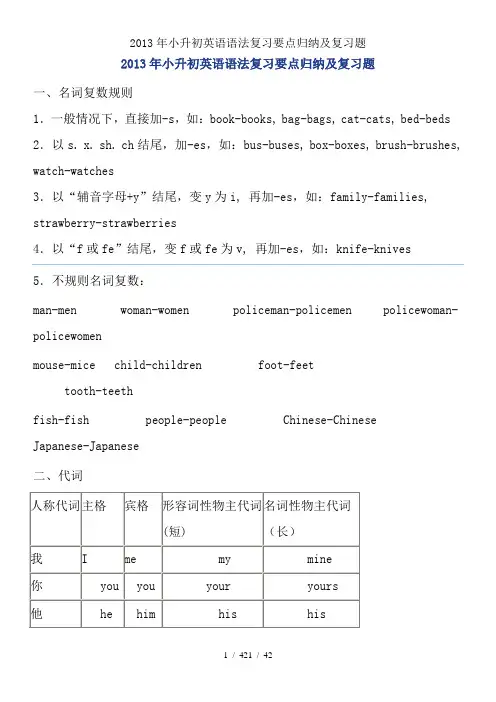
2013年小升初英语语法复习要点归纳及复习题一、名词复数规则1.一般情况下,直接加-s,如:book-books, bag-bags, cat-cats, bed-beds 2.以s. x. sh. ch结尾,加-es,如:bus-buses, box-boxes, brush-brushes, watch-watches3.以“辅音字母+y”结尾,变y为i, 再加-es,如:family-families, strawberry-strawberries4.以“f或fe”结尾,变f或fe为v, 再加-es,如:knife-knives5.不规则名词复数:man-men woman-women policeman-policemen policewoman-policewomenmouse-mice child-children foot-feettooth-teethfish-fish people-people Chinese-ChineseJapanese-Japanese二、代词口诀:主格应该作主语,放在句子的开头;宾格应该作宾语,放在动词介词后;形容词性的物主代词不能单独用,必须接名词或其他词;名词性的物主代词,单独使用就可以。
如:I am a student.What is your name?His bag is on the desk. That one is not his.We can from America. We are friends.Let me help you.These shoes are nice. Try them on.They are drinking tea.三、动词1. be动词:am is are2. 普通动词:have go come take get buy pass sit stand have talk walk see catch put等。
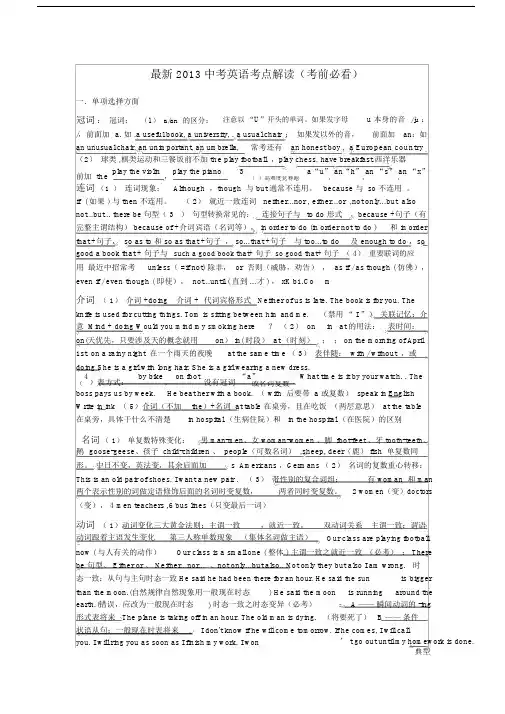
最新 2013中考英语考点解读(考前必看)一.单项选择方面冠词:冠词:(1)a/an 的区分:注意以“U”开头的单词。
如果发字母u 本身的音/ju :/,前面加 a. 如 .a useful book, a university, . a usual chair ;如果发以外的音,前面加an:如an unusual chair, an unimportant, an umbrella,常考还有an honest boy . a European country (2)球类,棋类运动和三餐饭前不加the play football,play chess. have breakfast.西洋乐器前加 the play the violin,play the piano 3 a“u” an“h” an “s” an “x”()高难度竞赛题;;;连词(1 )连词现象:Although ,though 与 but 通常不连用。
because 与 so 不连用。
if ( 如果 ) 与 then 不连用。
( 2)就近一致连词 neither...nor , either...or ,not only...but also not...but... there be 句型( 3 )句型转换常见的:连接句子与to do 形式,because +句子(有完整主谓结构) because of +介词宾语(名词等), in order to do (in order not to do ) 和 in order that +句子, so as to 和 so as that +句子, so...that +句子与 too...to do 及 enough to do ,so good a book that + 句子与such a good book that+ 句子 so good that+ 句子( 4)重要联词的应用最近中招常考unless( =if not) 除非, or 否则(威胁,劝告), as if / as though ( 仿佛),even if / even though ( 即使), not...until ( 直到 ...才 ) , xK b1.Co m介词( 1)介词 +doing 介词 + 代词宾格形式 Neither of us is late. The book is for you. The knife is used for cutting things. Tom is sitting between him and me. (禁用“ I ”)关联记忆:介意 Mind + doing Would you mind my smoking here ?( 2) on in at 的用法:表时间:on(天优先,只要涉及天的概念就用on) in( 时段) at (时刻);; on the morning of April 1st. on a rainy night 在一个雨天的夜晚at the same time ( 3)表伴随: with / without ,或doing She is a girl with long hair. She is a girl wearing a new dress.4)表方式:by bike,on foot没有冠词“a”What time is it by your watch. . The(或名词复数boss pays us by week. He beat her with a book. ( with 后要带 a 或复数) speak in EnglishWrite in ink ( 5)介词(不加the)+名词 at table 在桌旁,且在吃饭(两层意思) at the table在桌旁,具体干什么不清楚in hospital (生病住院)和 in the hospital (在医院)的区别名词( 1)单复数特殊变化:男 man-men、女 woman-women 、脚 foot-feet 、牙 tooth-teeth、鹅goose-geese、孩子 child-children 、 people(可数名词) ,sheep, deer(鹿) fish 单复数同形。
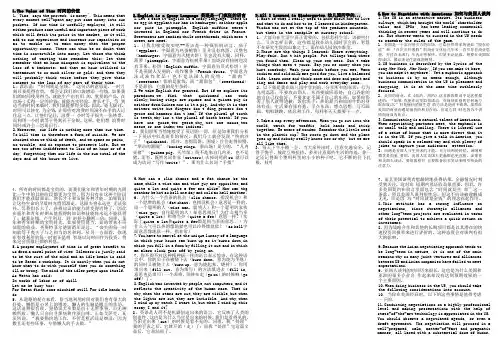
1.The Value of Time 时间的价值1."Time" says the proverb "is money". This means that every moment well-spent may put some money into our pockets. If our time is usefully employed, it will either produce some useful and important piece of work which will fetch its price in the market, or it will add to our experience and increase our capacities so as to enable us to earn money when the proper opportunity comes. There can thus be no doubt that time is convertible into money. Let those who think nothing of wasting time remember this; let them remember that an hour misspent is equivalent to the loss of a banknote; and that an hour utilized is tantamount to so much silver or gold; and then they will probably think twice before they give their consent to the loss of any part of their time.1、谚语说:“时间就是金钱。
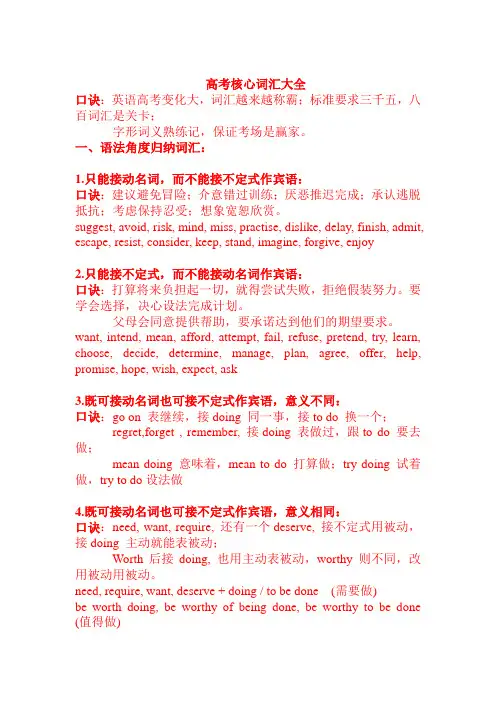
高考核心词汇大全口诀:英语高考变化大,词汇越来越称霸;标准要求三千五,八百词汇是关卡;字形词义熟练记,保证考场是赢家。
一、语法角度归纳词汇:1.只能接动名词,而不能接不定式作宾语:口诀:建议避免冒险;介意错过训练;厌恶推迟完成;承认逃脱抵抗;考虑保持忍受;想象宽恕欣赏。
suggest, avoid, risk, mind, miss, practise, dislike, delay, finish, admit, escape, resist, consider, keep, stand, imagine, forgive, enjoy2.只能接不定式,而不能接动名词作宾语:口诀:打算将来负担起一切,就得尝试失败,拒绝假装努力。
要学会选择,决心设法完成计划。
父母会同意提供帮助,要承诺达到他们的期望要求。
want, intend, mean, afford, attempt, fail, refuse, pretend, try, learn, choose, decide, determine, manage, plan, agree, offer, help, promise, hope, wish, expect, ask3.既可接动名词也可接不定式作宾语,意义不同:口诀:go on 表继续,接doing 同一事,接to do 换一个;regret,forget , remember, 接doing 表做过,跟to do 要去做;mean doing 意味着,mean to do 打算做;try doing 试着做,try to do设法做4.既可接动名词也可接不定式作宾语,意义相同:口诀:need, want, require, 还有一个deserve, 接不定式用被动,接doing 主动就能表被动;Worth后接doing, 也用主动表被动,worthy 则不同,改用被动用被动。
need, require, want, deserve + doing / to be done (需要做)be worth doing, be worthy of being done, be worthy to be done (值得做)5.接动名词作宾语,接不定式作宾补:口诀:禁止、建议和允许,接doing作宾语,接to do 作补语。
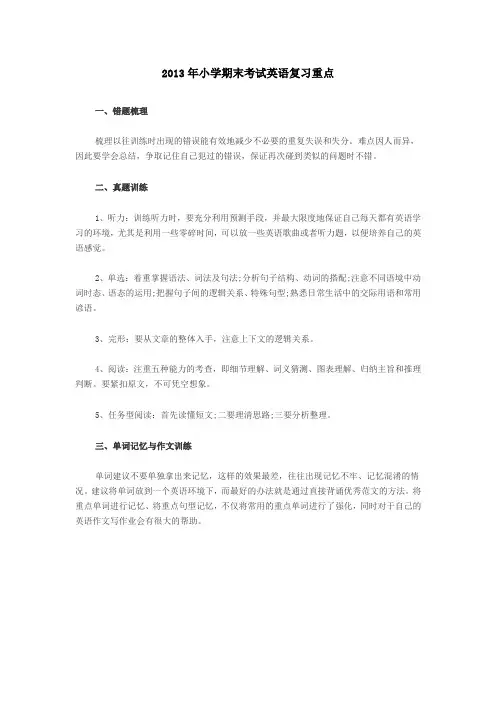
2013年小学期末考试英语复习重点
一、错题梳理
梳理以往训练时出现的错误能有效地减少不必要的重复失误和失分。
难点因人而异,因此要学会总结,争取记住自己犯过的错误,保证再次碰到类似的问题时不错。
二、真题训练
1、听力:训练听力时,要充分利用预测手段,并最大限度地保证自己每天都有英语学习的环境,尤其是利用一些零碎时间,可以放一些英语歌曲或者听力题,以便培养自己的英语感觉。
2、单选:着重掌握语法、词法及句法;分析句子结构、动词的搭配;注意不同语境中动词时态、语态的运用;把握句子间的逻辑关系、特殊句型;熟悉日常生活中的交际用语和常用谚语。
3、完形:要从文章的整体入手,注意上下文的逻辑关系。
4、阅读:注重五种能力的考查,即细节理解、词义猜测、图表理解、归纳主旨和推理判断。
要紧扣原文,不可凭空想象。
5、任务型阅读:首先读懂短文;二要理清思路;三要分析整理。
三、单词记忆与作文训练
单词建议不要单独拿出来记忆,这样的效果最差,往往出现记忆不牢、记忆混淆的情况。
建议将单词放到一个英语环境下,而最好的办法就是通过直接背诵优秀范文的方法。
将重点单词进行记忆、将重点句型记忆,不仅将常用的重点单词进行了强化,同时对于自己的英语作文写作业会有很大的帮助。
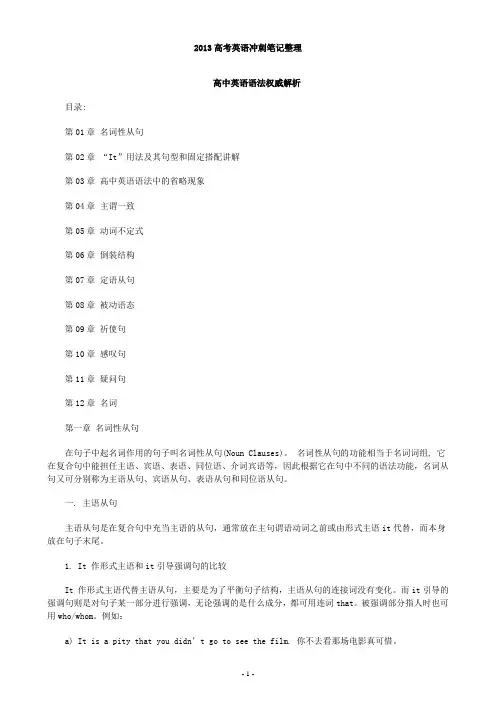
2013高考英语冲刺笔记整理高中英语语法权威解析目录:第01章名词性从句第02章“It”用法及其句型和固定搭配讲解第03章高中英语语法中的省略现象第04章主谓一致第05章动词不定式第06章倒装结构第07章定语从句第08章被动语态第09章祈使句第10章感叹句第11章疑问句第12章名词第一章名词性从句在句子中起名词作用的句子叫名词性从句(Noun Clauses)。
名词性从句的功能相当于名词词组, 它在复合句中能担任主语、宾语、表语、同位语、介词宾语等,因此根据它在句中不同的语法功能,名词从句又可分别称为主语从句、宾语从句、表语从句和同位语从句。
一. 主语从句主语从句是在复合句中充当主语的从句,通常放在主句谓语动词之前或由形式主语it代替,而本身放在句子末尾。
1. It 作形式主语和it引导强调句的比较It 作形式主语代替主语从句,主要是为了平衡句子结构,主语从句的连接词没有变化。
而it引导的强调句则是对句子某一部分进行强调,无论强调的是什么成分,都可用连词that。
被强调部分指人时也可用who/whom。
例如:a) It is a pity that you didn’t go to see the film. 你不去看那场电影真可惜。
b) It doesn’t interest me whether you succeed or not.我对你成功与否不感兴趣。
c) It is in the morning that the murder took place. 谋杀案是在早上发生的。
(强调句型)d) It is John that broke the window. 是John打碎的窗户。
(强调句型)2. 用it 作形式主语的结构(1) It is + 名词 + 从句It is a fact that … 事实是…It is an honor that …非常荣幸It is common knowledge that …是常识(2) It is + 形容词 + 从句It is natural that… 很自然…It is strange that… 奇怪的是…(3) It is + 不及物动词 + 从句It seems that… 似乎…It happened that… 碰巧…It appears that… 似乎…(4) It + 过去分词 + 从句It is reported that… 据报道…It has been proved that… 已证实…It is said that… 据说…3. 主语从句不可位于句首的五种情况:(1)if 引导的主语从句不可居于复合句句首。
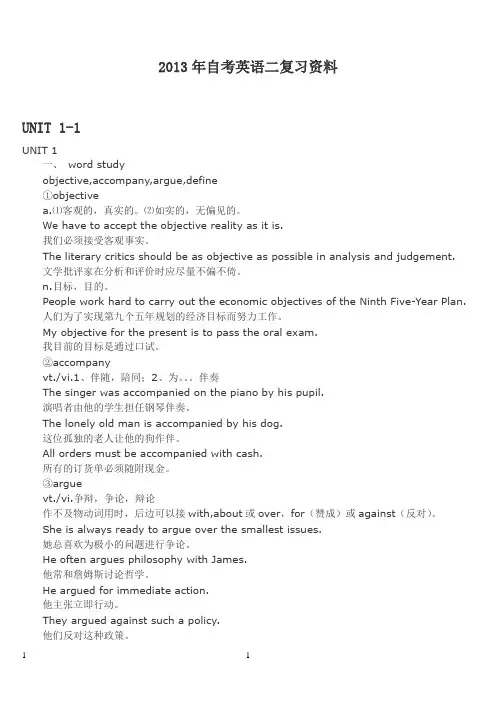
2013年自考英语二复习资料UNIT 1-1UNIT 1一、word studyobjective,accompany,argue,define①objectivea.⑴客观的,真实的。
⑵如实的,无偏见的。
We have to accept the objective reality as it is.我们必须接受客观事实。
The literary critics should be as objective as possible in analysis and judgement.文学批评家在分析和评价时应尽量不偏不倚。
n.目标,目的。
People work hard to carry out the economic objectives of the Ninth Five-Year Plan.人们为了实现第九个五年规划的经济目标而努力工作。
My objective for the present is to pass the oral exam.我目前的目标是通过口试。
②accompanyvt./vi.1、伴随,陪同;2、为。
伴奏The singer was accompanied on the piano by his pupil.演唱者由他的学生担任钢琴伴奏。
The lonely old man is accompanied by his dog.这位孤独的老人让他的狗作伴。
All orders must be accompanied with cash.所有的订货单必须随附现金。
③arguevt./vi.争辩,争论,辩论作不及物动词用时,后边可以接with,about或over,for(赞成)或against(反对)。
She is always ready to argue over the smallest issues.她总喜欢为极小的问题进行争论。
He often argues philosophy with James.他常和詹姆斯讨论哲学。
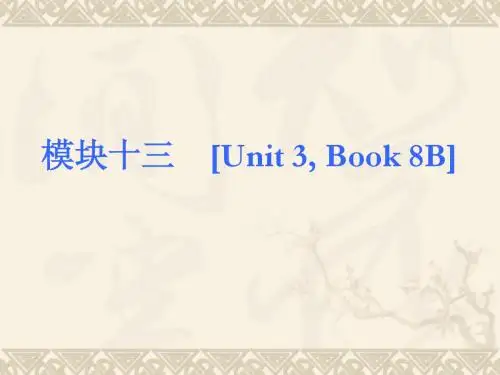
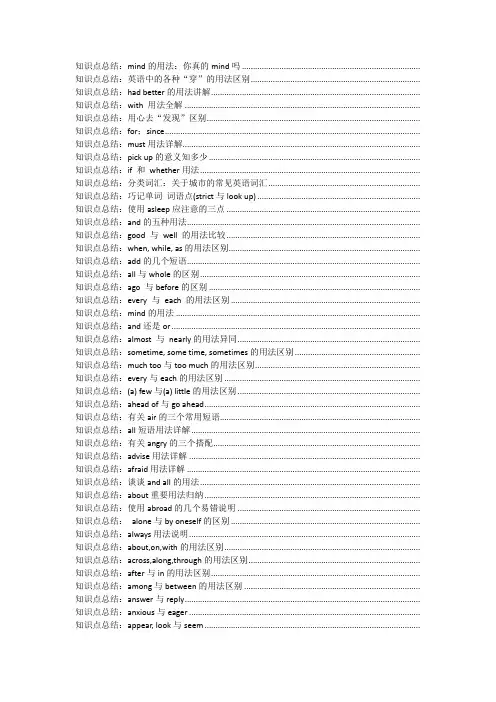
知识点总结:mind的用法:你真的mind吗 ................................................................................. 知识点总结:英语中的各种“穿”的用法区别............................................................................. 知识点总结:had better的用法讲解............................................................................................... 知识点总结:with 用法全解 ........................................................................................................... 知识点总结:用心去“发现”区别................................................................................................. 知识点总结:for;since .................................................................................................................... 知识点总结:must用法详解............................................................................................................ 知识点总结:pick up的意义知多少 ................................................................................................ 知识点总结:if 和whether用法.................................................................................................... 知识点总结:分类词汇:关于城市的常见英语词汇..................................................................... 知识点总结:巧记单词词语点(strict与look up) .......................................................................... 知识点总结:使用asleep应注意的三点 ........................................................................................ 知识点总结:and的五种用法.......................................................................................................... 知识点总结:good 与well 的用法比较 ........................................................................................ 知识点总结:when, while, as的用法区别....................................................................................... 知识点总结:add的几个短语.......................................................................................................... 知识点总结:all与whole的区别 .................................................................................................... 知识点总结:ago 与before的区别 ................................................................................................ 知识点总结:every 与each 的用法区别 ...................................................................................... 知识点总结:mind的用法 ............................................................................................................... 知识点总结:and还是or ................................................................................................................. 知识点总结:almost 与nearly的用法异同................................................................................... 知识点总结:sometime, some time, sometimes的用法区别......................................................... 知识点总结:much too与too much的用法区别........................................................................... 知识点总结:every与each的用法区别 ......................................................................................... 知识点总结:(a) few与(a) little的用法区别 ................................................................................... 知识点总结:ahead of与go ahead .................................................................................................. 知识点总结:有关air的三个常用短语........................................................................................... 知识点总结:all短语用法详解 ........................................................................................................ 知识点总结:有关angry的三个搭配.............................................................................................. 知识点总结:advise用法详解 ......................................................................................................... 知识点总结:afraid用法详解 .......................................................................................................... 知识点总结:谈谈and all的用法.................................................................................................... 知识点总结:about重要用法归纳 .................................................................................................. 知识点总结:使用abroad的几个易错说明 ................................................................................... 知识点总结:alone与by oneself的区别 ...................................................................................... 知识点总结:always用法说明......................................................................................................... 知识点总结:about,on,with的用法区别......................................................................................... 知识点总结:across,along,through的用法区别.............................................................................. 知识点总结:after与in的用法区别 ............................................................................................... 知识点总结:among与between的用法区别 ................................................................................ 知识点总结:answer与reply ........................................................................................................... 知识点总结:anxious与eager ......................................................................................................... 知识点总结:appear, look与seem ..................................................................................................知识点总结:arrive, get与reach ..................................................................................................... 知识点总结:beat, hit, strike的区别 ............................................................................................... 知识点总结:wrong的用法 ............................................................................................................. 知识点总结:would与used to的区别............................................................................................ 知识点总结:形容词ashamed的两个搭配 .................................................................................... 知识点总结:ask短语用法归纳 ...................................................................................................... 知识点总结:attend to的用法......................................................................................................... 知识点总结:attention搭配大全..................................................................................................... 知识点总结:behind用法与搭配 .................................................................................................... 知识点总结:beginning习语归纳.................................................................................................... 知识点总结:bed短语归纳.............................................................................................................. 知识点总结:bad搭配三用法.......................................................................................................... 知识点总结:介词above用法详解................................................................................................. 知识点总结:across的用法与易错说明.......................................................................................... 知识点总结:at, in与on的用法区别 ............................................................................................. 知识点总结:almost与nearly用法区别详解................................................................................. 知识点总结:你知道what,which,who的区别吗 ............................................................................ 知识点总结:arrive, get与reach的用法区别 ................................................................................ 知识点总结:leave与forget的用法区别........................................................................................ 知识点总结:feel like用法小结 ....................................................................................................... 知识点总结:borrow与lend的三大区别....................................................................................... 知识点总结:because of的用法 ...................................................................................................... 知识点总结:word的搭配与用法 ................................................................................................... 知识点总结:without的几条用法说明 ........................................................................................... 知识点总结:英语中只能用复数形式的名词................................................................................. 知识点总结:初中英语词汇短语.....................................................................................................知识点总结:mind的用法:你真的mind吗1.Vt. 照看、照管,= look after = take care of的意思,例如:He promised to mind the baby while we were out.Mind your own business! 管好你自己的事情。
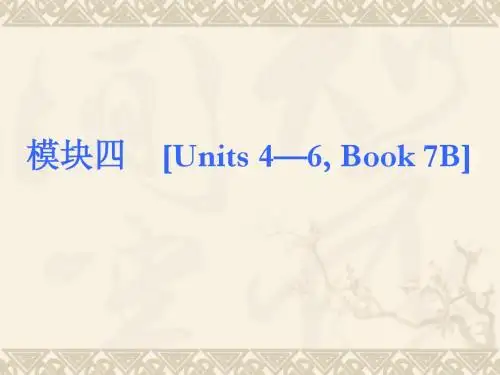
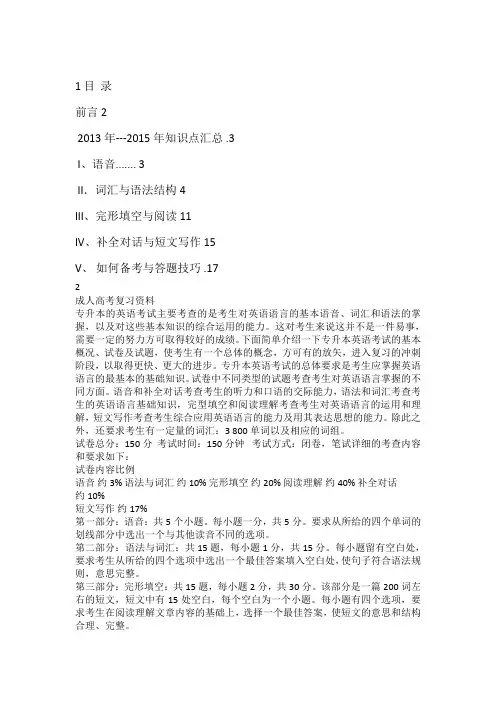
1 目录前言 22013年---2015年知识点汇总 .3I、语音 (3)II.词汇与语法结构4III、完形填空与阅读 11IV、补全对话与短文写作 15V、如何备考与答题技巧 .172成人高考复习资料专升本的英语考试主要考查的是考生对英语语言的基本语音、词汇和语法的掌握,以及对这些基本知识的综合运用的能力。
这对考生来说这并不是一件易事,需要一定的努力方可取得较好的成绩。
下面简单介绍一下专升本英语考试的基本概况、试卷及试题,使考生有一个总体的概念,方可有的放矢,进入复习的冲刺阶段,以取得更快、更大的进步。
专升本英语考试的总体要求是考生应掌握英语语言的最基本的基础知识。
试卷中不同类型的试题考查考生对英语语言掌握的不同方面。
语音和补全对话考查考生的听力和口语的交际能力,语法和词汇考查考生的英语语言基础知识,完型填空和阅读理解考查考生对英语语言的运用和理解,短文写作考查考生综合应用英语语言的能力及用其表达思想的能力。
除此之外,还要求考生有一定量的词汇:3 800单词以及相应的词组。
试卷总分:150分考试时间:150分钟考试方式:闭卷,笔试详细的考查内容和要求如下:试卷内容比例语音约3% 语法与词汇约10% 完形填空约20% 阅读理解约40% 补全对话约10%短文写作约17%第一部分:语音:共5个小题。
每小题一分,共5分。
要求从所给的四个单词的划线部分中选出一个与其他读音不同的选项。
第二部分:语法与词汇:共15题,每小题1分,共15分。
每小题留有空白处,要求考生从所给的四个选项中选出一个最佳答案填入空白处,使句子符合语法规则,意思完整。
第三部分:完形填空:共15题,每小题2分,共30分。
该部分是一篇200词左右的短文,短文中有15处空白,每个空白为一个小题。
每小题有四个选项,要求考生在阅读理解文章内容的基础上,选择一个最佳答案,使短文的意思和结构合理、完整。
第四部分:阅读理解:共20个小题,每小题3分,共60分。
2013中考复习系列一词汇词类知识一、中考要求:词汇是英语的基础,而弄清每一个词的词类是用词、造句、阅读和写作的基础。
词类在中考的考查一般通过在名词、动词、形容词等各种词性的考查中表现出来。
如判断各类词在句子中可以作的成分来决定使用哪个词形,词与词之间的搭配关系等。
二、知识要点:根据语法功能,词可分为十类:名词、代词、动词、形容词、副词、数词、冠词、介词、连词和感叹词。
1. 名词(n.):名词用来表示人、事物或抽象概念,如:boy 男孩,morning 早晨,duty 责任;在句子中主要作主语、表语、宾语、补足语、同位语、定语等。
例如:The tomatoes on the table are very fresh. 桌子上的西红柿很新鲜。
(作主语)He is a doctor. 他是个医生。
(作表语)We’ll call the baby Mary. 我们要给这个婴儿取名玛丽。
(作宾语补足语)2. 代词(pro.):代词用来代替名词或数词,如:we 我们,their 他们的,that 那个,several 几个;在句中主要作主语、宾语、表语、同位语等。
例如:I know her sister. She is always ready to help others. 我认识她妹妹,她乐于助人。
(I和she作主语;her作定语;others作宾语)The English teacher is not himself today. 英语老师今天不舒服。
(作表语)3.数词(num.)数词表示数目和顺序,即基数词和序数词。
如:one 一个,thousand 千,twelfth 第十二;在句子主要作主语、宾语、表语、定语等。
例如:Three of us are from Beijing. 我们中有三个人是北京来的。
(作主语)You are the second one to come to see me. 你是第二个来看我的人。
巡场中学2013级英语语法复习提纲姓名_______ 班级_______一..1.名词:包括可数名词,即数得清的名词(单数和复数)和不可数名词.,即数不清的名词,没有单复数之分. 2.可数名词单数变复数的规则变化(1)一般情况直接+S;(2)以s , x , ch , sh 结尾的+es;(3)以辅音字母+y结尾的,变y 为i再加es; (4) 以f /fe 结尾的,变f /fe为v再+es;(5)以o 结尾的,一般情况+s ,但顺口溜中提到的要+es: 黑人英雄(hero—heroes)吃土豆(potato---potatoes)和西红柿(tomato-----tomatoes)3.不规则变化:男子man---men ;妇女woman ----women ;这this ----these这些;那that----those 那些;小孩子child -----children;中国人Chinese --Chinese;人们people—people;foot ---feet 脚;tooth---teeth 牙齿; sheep --sheep 绵羊;deer –deer 鹿子;mouse --mice 老鼠4.练习:写出下列名词的复数形式。
box________ strawberry _______ people _________ this ______ watch________ family________ child __________- that _______ life _______ tomato_________5.单数句变复数句的有关知识:this----these; that ---those ; is/am----are; he /she /it ---they;6.练习:(1)That is her watch.(同上)_______ _______her _________.(2) Those are erasers. (改为单数句)_______ ________ ________ _________.7.一个名词修饰另一个名词,前面的名词相当于一个形容词,只能给单数形式,但当前面的名词为man 或woman 时,要变为相应的复数。
2013年七年级下册复习资料(新教材)Unit 1 Can you play the guitar?一、重点语法:情态动词can的用法1.can的意思是:能,会(表能力)可以(表允许)。
can是情态动词,无人称和数的变化,位于主语后,实意动词前。
肯定句变为否定句直接在can后加not; 变为一般疑问句直接把can提到句首即可。
2.句型为:〃肯定句:主语+ can + 动词原形+ 其他成分.〃否定句:主语+ can not ( can’t )+ 动词原形+其他〃一般疑问句:--Can +主语+动词原形+ 其他?肯回:---Yes, 主语+can.否回:--No, 主语+can’t.二、重点短语:play the guitar/piano/violin/drums/ play basketball play chess play games tell stories tell jokes talk to sb English club speak English make friends be good with sb want to do sth need sb to do sth call sb at +电话号码 have time =be free wanted for be good at doing sth school show do kung fu after school join the …club like to do sth like doing sth the story telling club三、重点句型:1. –Can you draw?- Yes, I can / No, I can’t.2. -What club do you want to join?- I want to join the art club.3. - What sports can you play?-Soccer.4. Sounds good.5. I can speak a little English and I can also play chess.6.I’m in the school music club.7.What can you do?中考链接单选题()1.—Who is man in a black hat?--It’Jim Brown.We often play basketball together in our freetime.A. an,aB.a, /C.the, aD.the, /()2.- you turn down your radio station?-Yes,I can.A.MayB.NeedC.canD. Can()3.-Listen,the music sweet.- It’s Yesterday Once More,my favorite.A.soundsB.smellsC.feelsD.looks()4. Be quick, we’ll be late for school.A.andB.orC.soD.of()5. sleep too late. It’s bad for your health.A.DoB. NotC.Don’tD.Please not()6.We only have one earth,It’s our common(共同的) .A.familyB.houseC.homeD.room()7. Do you want to the music club?A.joinB. join inC. joinsD. joins in()8.—Are you kids?--Yes,I like kids very much.A.good withB.likeC.good atD.like with()9.—Do you often play soccer with your friends?--No,I don’t like sports. I often play piano.A.a,theB.the, /C./, theD.the, a()10.The cake tastes(尝起来) and it sells .A.good,goodB.well,wellC.good,wellD.well,good用所给单词的适当形式填空1.It’s a beautiful,______ day. (sun)2. This is the ______ _ of the story. (begin)3. They can _______the guitar well. (play)4. How many _____ can you see in the room? (man)5. Mary enjoys _______ football games very much. (watch)6. Thanks for _____ me so much help. (give)7. Lin T ao wants ________ an actor when he grows up. (be)8. Nancy likes _____ to music. (listen)9. Can you and your brother________ ? (swim)10. Look! The children ______ happily over there. (play)Unit 2 What time do you go to school?重点语法:一、辨析:what time 和whenwhat time 和when都可以对时间进行提问,表示“什么时候”。
九年级2013英语知识点IntroductionIn this article, we will cover the key English language knowledge points that are typically taught in the ninth grade in 2013. These knowledge points are essential for students to build a solid foundation in English and prepare them for more advanced language skills. Let's dive into the various areas of English language learning in the ninth grade.1. Grammar1.1 Verb Tenses- Simple Present Tense: Used for general truths, habits, and permanent situations.- Present Continuous Tense: Describes actions happening at the present moment.- Simple Past Tense: Used for actions completed in the past.- Past Continuous Tense: Describes actions that were in progress at a specific time in the past.- Present Perfect Tense: Shows actions that started in the past and continue in the present.- Past Perfect Tense: Describes actions completed before a certain point in the past.- Future Tenses: Different ways to express future actions, including the use of "will," "be going to," and the present continuous tense.1.2 Modals- Can/Could: Expresses ability, possibility, or permission.- May/Might: Used to express possibility or permission.- Should: Indicates advice or obligation.- Must: Shows necessity or strong obligation.1.3 Adjectives and Adverbs- Comparative and Superlative Forms: The comparison of adjectives and adverbs.- Position of Adjectives: Understanding when and where to use adjectives.- Degree of Adjectives: Adjectives describing the intensity or extent.2. Vocabulary2.1 Word Formation- Prefixes: Understanding how adding prefixes changes the meaning of a word.- Suffixes: Understanding how adding suffixes changes the function or meaning of a word.2.2 Synonyms, Antonyms, Homonyms- Synonyms: Words with similar meanings.- Antonyms: Words with opposite meanings.- Homonyms: Words that sound the same but have different meanings.2.3 Idioms and Phrases- Common idioms and phrases in English and their meanings.- Figurative Language: Understanding metaphors, similes, and personification.3. Reading Comprehension3.1 Skimming and Scanning- Techniques for quickly extracting information from a text.3.2 Inference- Drawing conclusions based on implied information in the text.3.3 Understanding Context- Determining the meaning of unfamiliar words based on the surrounding text.4. Writing Skills4.1 Essay Writing- Developing a clear and coherent essay structure.- Using appropriate language and vocabulary.- Writing an introduction, body paragraphs, and a conclusion.4.2 Narrative Writing- Describing experiences, events, and personal stories.- Incorporating dialogue and descriptive language.ConclusionThe ninth grade English curriculum in 2013 encompasses a wide range of language skills, grammar rules, vocabulary, reading comprehension, and writing skills. Mastering these knowledge points is crucial for students to become proficient in English. Continuous practice and exposure to the English language will further enhance their abilities to communicate effectively and confidently.。
1.Meeting is a general and summary term of various kind of assembly of people for a particular purpose.2.Conference is a kind of formal meeting, often lasting for a few days. It is organized on a particular subject to bring together people who have a common interest.3.Symposium refers to the meeting for specialized academic discussion. Compared with conference, a symposium is usually narrower and more specific in the range of topics.4.Convention is a kind of routine meeting, a regularly organized by a learned society, a professional association, an academic institution or a non-governmental organization.5.Seminar is a class-like meeting, where participants discuss a particular topic and subject that is presented by several major speakers.6.Workshop refers to a period of discussion or practical work on a particular subject in which a group of people learn about the subject by sharing their knowledge and experience.7.Forum is a kind of public meeting, at which people exchange ideas and discuss issues, especially important public issues.8.Congress is usually attended by representatives and delegates who belong to national or international, governmental or non-governmental organizations.9.Colloquium is sometimes a formal word for seminar. It is usually a large academic seminar like panel discussion. Colloquium is usually attended by certain invited experts or professionals in a particular field.0.Principal Conference Activities1)Formal meetings: General assembly; Plenary sessions; parallel sessions; Poster sessions;2)informal meetings:free information exchange; Free paper presentation;3)audioand visual presentation4)teaching and consulting services5)exhibitions and business talks6)visits and other social activites1、classification of professional paperReport paper(专题)、Research paper(研究)、Course paper(课程)、Thesis paper(答辩).1)Report paper: The report paper summarizes and reports the findings of the author(s) on a particular subject.2)Research paper: A complete research paper is usually composed of the following elements:title, author, affiliation, abstract, keywords, introduction, theoretical analysis, results and discussion or conclusion, reference, etc.3)Course paper This type of paper is always written and handed in at the end of the term, it is also called “term paper.”4)Thesis paper: A Dissertation (thesis paper) is usually written and submitted inpartial fulfillment of the requirements for the degree of MA or MS (or Ph. D) in a specific discipline.2、ways of preparing professional papers1)Searching for good ideas. coming from practice and back to practice. 2) Finding topics:3)Considering Audience and Purpose.4)Moving from Brainstorming to Drafting5)Editing and Refining3.General Functions of Title:1) Generalizing the Text; 2) Attracting the Reader;3) Facilitating the RetrievalGeneralizing the Text: A tile should summarize the central idea of the paper concisely andcorrectly. Attracting the Reader: An interestingtitle may draw particular attention amongprofessionals. Facilitating the Retrieval: A goodtitle can help the reader in his search forinformation.4.Linguistic Features of Title:1) Using More Nouns, Noun Phrases andGerunds: The words or phrases used in a title arevery often nouns, noun phrases or gerunds,nominalization, which usually are keywords forthe paper, having the ability to sum up the wholetext; 2) Using an Incomplete Sentence: A title isjust a label or appellation of the paper, reflectingthe main idea of the contents.5.Writing Requirements of Title:1) Be Brief and Concise; 2) Be Specific; 3) AvoidQuestion Titles; 4) Being Unified; 5) BeingStandardBe Brief and Concise: A title of a paper shouldbe brief and concise, being composed of no morethan twenty words. If a title is too long, it wouldbe difficult for readers to catch the meaning ofthe content and remember it. Be Specific:Thetitle should highlight the emphasis andparticularity of the work. Avoid Question Titles:A question title means a complete sentence in thequestion form. And such a title createsinconvenience for the information retrieval.Being Unified: The parallel parts of a title shouldbe grammatically symmetrical. Being Standard:Nonstandard abbreviations and symbols shouldbe avoided.6.General Functions of Author/Affiliation:Author:1)Bearing Author’s Responsibility. Itmeans if any consequence should arise from thepublication of the paper, the author(s) should takeit without affecting others; 2) FacilitatingRetrieval and Correspondence. Names of author(s)and institutional affiliations are usually used asauthor indexing, designed in the informationreferencing network. Readers can correspondwith the author, according to the affiliation; 3)Heightening Celebrity. The publication of aresearch paper brings reputation to author’sinstitution and country.Affiliation:1) Facilitating correspondence; 2)Bringing the reputation to the author’s institutionand his country7.Writing Requirements of Author/Affiliation:1) Printing Format Unified; 2) Number of Author(the number of authors should not be over four);3) Professional Title Omitted; 4) Address (beingwritten from the smaller unit to the larger ones); 5)Internal Units8.General Functions of Keywords:1) Easiness of Retrieval;2) Easiness of Highlighting9.Linguistic Features of Keywords:1) Nominalization; 2) Limited Number;3) Designated ChoiceNominalization: Keywords are usually used inthe form of nouns, not verbs. Limited Number:The number of keywords for a paper should belimited. Four to six keywords are the average. Ingeneral, there should be at least 2 and at most 8.Designated Choice:The keywords of a paperusually come from the title and/or the abstract.10.Writing Requirements of Keywords:1) Using Required Terms. The terms of“keywords”should be consistent with therequirements of the journal to which you submityour paper; 2) Placing in Right Location. In mostcases, keywords are placed below the abstract; 3)Spacing the Keywords. Use comma, semicolon orlarger space to separate the words; 4) AdoptingStandard Abbreviations. Standard abbreviationsare preferred in the section of keywords.11.General Functions of an Abstract:Miniaturizing the text; Deciding: “yes” or “no”;Expanding the circulationMiniaturizing the text: a mini-version or aminiature of the document, summarizing thecontent of the main body.Deciding: “yes” or“no”: directly influence the paper’s acceptance toa learned journal. Expanding the circulation: Itcan be circulated much wider and farther than thepaper itself, thus producing wider and deeperacademic influence than the full text of the paper.12.Linguistic Features of Abstract:Limited length; Categories of abstracts;Complete content; Formalized structureLimited length: 200 words should be a sensiblemaximum for a relatively long paper or report,but never more than 500 words; 50-100 wordsmay suffice for a short article. Categories ofabstracts:Abstracts can be classified into threecategories: indicative, informational andinformational-indicative. Complete content:However short abstract may be, all the relevantelements should be included. Formalizedstructure:A complete abstract usually consistsof three major parts: topic sentence, supportingsentence and concluding sentence.13.Writing Requirements of Abstract:Integrity; Concise; Consistency; ConcentrationIntegrity: It should contain certain elements ofinformation. Generally, an abstract should includewhat the writer has done and what he hasachieved within the scope of the topic. Concise:Use only essential information. Consistency: Anabstract should be consistent with the other partsof the whole paper. Concentration: You need toomit certain elements of information. Do not usefigures, tables, or literature references in this part.14.“5 Steps” in the Abstract Writing1) Underlining Key Words and Sentences; 2)Listing Essential Points of the Paper; 3) Boilingdown/summarizing Each Section to/into aSentence or Two; 4) Drafting the Abstract; 5)Checking the Final Draft15.“5A Strategy” in Abstract WritingBefore writing abstract, you need to answer somebasic questions.Q1: What is the general knowledge of your topicin the academic field?Q2: What research topic is the paper to focus on?Q3: What method or material do you use tosupport your main point of view?Q4: What conclusion will you draw?Q5: What is the main contribution of the paper?Then the abstract can be improved on by usingthe following formula:Abstract=A1+A2+A3+A4+A5A1: background A2: main topicA3: specific investigationsA4: result & suggestionA5: conclusion & contribution16.How can it be helpful in your abstractwriting?With the “5A Strategy” in mind, you can getsome useful prompts. Though different papersrequire different abstracts, many abstracts may share similar functions and lead to a similar organization scheme. This 5A Strategy will surely enable you to produce an appropriate and even quite successful abstract without much trouble. mon Errors/Likely Mistakes:1) Mixed writing style: mixed informal writing style with the formal writing style2) Over-simplified statements: The abstract is too simple to inform the authors’ information.3) Monotonous expression: These abstract sentences are monotonous including that the verb appears many times in a short passage and there is no passive voice.4) Incomplete contents5) Displacement of information18.General Functions of Introduction: Introducing the Subject; Limiting the Research Scope; Stating the General Purpose; Showing the Writing ArrangementIntroducing the Subject:Since the topic in the introduction is what the paper is going to deal with, the readers can get a preliminary but overall impression before going on with the full text of the paper. Limiting the Research Scope:Only when an introduction clearly defines the limits of the research scope can readers retrieve the information efficiently provided that the subject is introduced correctly. Stating the General Purpose:The function of stating the general purpose is aimed at telling the reader why to where to start or where to guide. Showing the Writing Arrangement: The logical arrangement of the writing enables the reader to understand the paper more easily when further reading is necessary.19.Structural Features of Introduction: Starting with the Research Background; Transiting to the Existing Problem;Focusing on the Present ResearchStarting with the Research Background:That is to answer the question, “What have been done?”Transiting to the Existing Problem: That is to answer the question: “What have not been done?”Focusing on the Present Research: That is to answer the question: “What I am going to do?”20.The differences between objective description and subjective description? (1)Objective Description:A professional author has to focus on the object he is portraying rather than on his personal reactions to it. All the related situations require a precise description of the conditions or processes his research involves. And in such cases his goal is to supply information-to build up as accurate a picture as he can for his readers.(2)Subjective Description:To show the author’s impressions of or responses to what they see. 21.General Requirement for ResearchDescriptionPresenting a Picture of the Object.Illustrating the Object in Artificial Language. Making Necessary Comparison.Sizing the Object Specially.Locating the Object Correctly. Carefully. Generalizing/Systematizing the Observation 22.L ogical Development1)Developing by Chronological Sequence2)Developing by Investigation Procedures3)Developing the Research “from Abstract to Concrete”(deductive method )演绎法4)Developing the Research “from Concrete toAbstract”(inductive method)归纳法5)Developing by Using Other Logical Sequencing23.Reasoning(Persuasion)劝导法/推理The task of reasoning is to justify the writer’sinference and try to persuade the readers of theproposals offered by the writer.24.General Functions and Contents of Results:The value of a research lies in the value of itsfinal results and the author’s interpretation of theresults. In the section of the results, the authorshould bring about a solid foundation on whichthe whole paper rests, by boiling down all thefacts he has gained. There are two ingredients inthe section of result: full presentation of thespecific data of the work and detailed analysis ofthe results.25.Writing Requirements of Results:1) any data shown in the section must bemeaningful; 2) the presentation of results shouldbe short without verbiage and be of crystalclarity.26.General Functions and Main Elements ofDiscussion:The purpose of discussion is to expound theinterrelations among the observed facts. Thissection is to show the relationship between thefacts,their underlying causes, their effects, andtheir theoretical implications.Discussion usually include: 1) Analyzing the data;2) Pointing out doubts; 3) Expoundingviewpoints; 4) Stating the significance; 5)Arriving at a conclusion.27.General Functions of Conclusion1) summing up; 2) statement of conclusions; 3)statement of recommendations; 4) gracefultermination28.What are the criteria in distinguishing aresult from a conclusion?1) a result states the objective facts and datagained in the paper together with correspondinganalysis concerned and generalizes the results toa theoretical height, while a conclusion shows thefinal viewpoint drawn by the author(s) afterinvestigations, experiments, discussions,inferences, etc. So the former is objectivedescription while the later is evaluation based onthe former with subjective elements involved in.2) if the section of a result is to bring about asolid foundation which the whole paper rests, byboiling down all the facts and data the researchershave gained, the purpose of a conclusion is toexpound the interrelations among the observedfacts, including summing up, stating conclusionsand recommendation and achieving gracefultermination.3) a conclusion is often located after a result.4) presentation of any meaningful data shown inthe section of a result should be short withoutverbiage and be of crystal clarity. But aconclusion should be cautiously drawn withouterrors and ambiguous understanding.29.General Functions of Acknowledgements:Acknowledgments function is to express theauthor(s) appreciation. Acknowledgments ismainly used to extend the author(s)’sindebtedness to the helpful support or concernfrom his(their) colleagues in offering any usefulmaterial, technical know-how, suggestions, orany kind of enlightenment, etc. to the author(s).30.Linguistic Features of Acknowledgements:1) Patternized content; 2) Formalized expressionsWriting Requirements of Acknowledgements:1) Being specific; 3) Asking for permission2) Avoiding under-or over-statements;31. General functions of References:1)Showing Respect to the Previous Works;2)Facilitating the literature search.32.“Two systems” of References:1) Name and Year System (Harvard System):Name and year system means the references arealphabetically arranged and headed by theauthor’s name, the year of publication, the title ofthe publication, the publisher, the page numberand so on. (the title of the journal is italicize)2) Citation Oder System: Citation order systemmeans the references are not alphabeticallyarranged but according to the order of appearanceof the cited works.The title of the book/articles are omitted; the titleof the journals are abbreviations; the year ofpublications is placed at the end; only the firstauthor’s name is listed, if more than one author,“et al.” will be used.Writing requirements of References:Correct in content;Unified in style33.Plagiarism: the use of another person's ideasor words without giving him/her the proper credit;or, the action of taking (words, ideas, etc.) fromsomeone else's work and use them in one's ownwork without admitting one has done so.2 Writing a letter1)write a letter to an editor in a major journal inyour field, asking for some relevant writtenmaterials available.询问进展We submitted the paper (No.xxx) entitled“XXXXXX” to you for publication in theXXXXX three months ago. Could you give us anupdate on the current status of our submission?Any information will be greatly appreciated.Thank you very much for your considerationsuppose that you are going to submit yourarticle/paper for publication in a famous journalin your area. Prepare a cover letter.Sample:assume that you have received a letter from theeditor, saying your paper has been accepts, butneed some revisions. Write a reply to editor.4) write a letter to your editor, assuming you wantto revise your manuscript that been accepted bythe journal. Sample:。